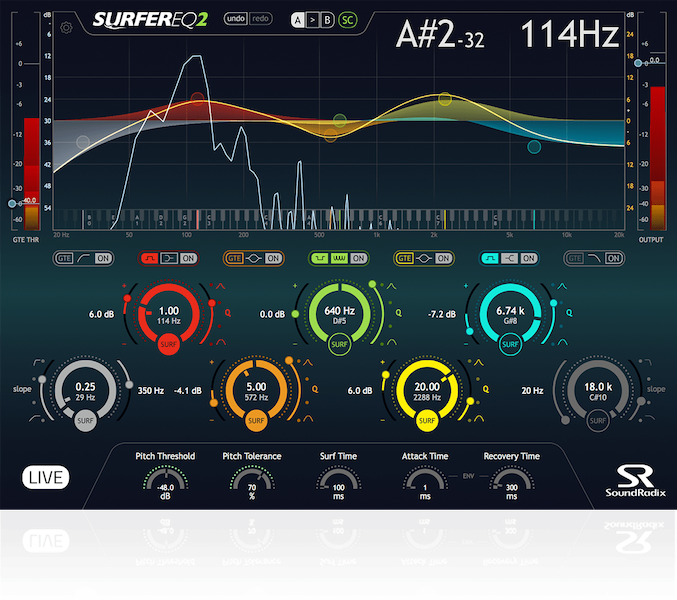SurferEQ 2 by Sound Radix is a genuinely innovative equalizer plugin. It’s been around for a while now, but that doesn’t mean it’s any less impressive today than it was at release. Sound Radix incorporated real-time pitch-tracking technology to completely reimagine what an EQ can be.
SurferEQ 2 Features
SurferEQ’s primary feature is adaptive pitch-tracking. Let’s wrap our heads about that means for an EQ, and why it’s so useful. This plugin can track the fundamental frequency of any incoming monophonic signal. It then moves the selected band across the frequency spectrum in real time, so that any boosts/cuts apply to every pitch.
The result is a more dynamic EQ, where there won’t be major peaks or dips in level depending on the fundamental frequency being played. For instance, take a bass guitar with a 100 Hz boost. Whenever the bassist plays a fundamental around 100, it will be louder; but if they play a funky lick in a higher octave, it will sound quieter because there’s no boost around those fundamentals.
SurferEQ has 7 bands, all of which have the adaptive ‘surf’ function. You don’t have to enable surfing, though, and can still use it like a static EQ. Obviously the real draw to SurferEQ is the pitch-tracking, though.
Specs:
- Groundbreaking pitch-tracking equalizer
- Original asymmetric, morphing EQ algorithms
- Innovative Harmonic Filter
- Side-chain input enabling external pitch detection
- Spectral Gate (normal and reversed)
- 3-mode MIDI control, including an innovative EQ Instrument mode
- Zero-latency mode
- Spectrum analyzer and Spectral Level Meters
- Undo/redo
- 64-bit internal processing
SurferEQ vs. FabFilter
FabFilter is one of the most popular EQ plugins ever. Engineers love it for its precision, transparency, streamlined GUI, and useful spectrum analyzer. It’s definitely a go-to multi-purpose equalizer.
FabFilter’s Pro-Q 3 features dynamic functionality, but it does not include pitch-tracking like SurferEQ 2. The dynamic mode on Q 3 works like a multi-band compressor. You can individually toggle bands to boost/cut by a certain amount, only after they surpass a chosen threshold. While incredibly useful, it doesn’t adapt to the incoming signal in real time and automatically slide the band around based on the fundamental frequency.
SurferEQ and Pro-Q are really two different beasts. They don’t share much beyond a spectrum analyzer. With SurferEQ you’re limited to 7 bands, while FabFilter’s are virtually endless (it’s actually up to 24). And that’s just comparing them superficially.
FabFilter is the ultimate workhorse EQ, while SurferEQ is unique and innovative—almost a novelty, though it is quite groundbreaking. It does its thing well. If you don’t see the necessity of adaptive pitch-tracking and automatic band adjustment, then FabFilter would be the better choice.
Conclusion
There’s nothing quite like SurferEQ 2. SoundRadix really flipped the script with this one, developing a totally unique equalizer plugin that makes up for some of the shortcomings/inconveniences of traditional static EQs. It probably wouldn’t be the first EQ you’d reach for to make some minor adjustments, and certainly not one you’d go for to color an instrument. But if you’re struggling to keep the fundamentals at a consistent level across the frequency spectrum, SurferEQ will do just that.
- SEE ALSO: Vocal EQ Tips for Beginning Mixers
